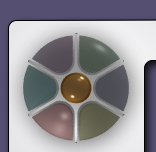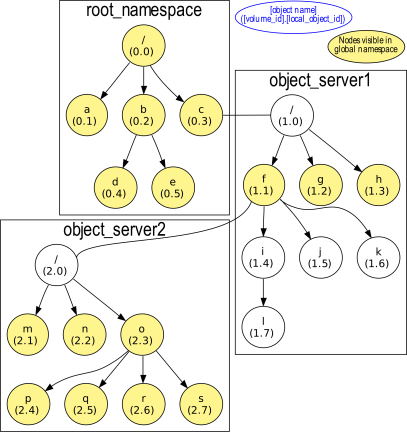 |
 |
 |
 |
 |
 |
| Impressum |
| Maintainer |
| Webmaster |
 |
 |
 |
 |
||
| L4VFS - L4 virtual file system layer | |||
 |
 |
||
 |
|

|
By clicking here (in the Demo-CD version of this document) you can start an interactive file system browser for this demo setup. You can explore the name space of the currently running demo setup by expanding the directory nodes. In this setup there are three interesting servers running:
-
The
vc_server(mounted to/server/vc) provides virtual consoles, which are discussed on the next pages, -
The
simple_file_server(mounted to/server/sfs) provides static read-only files for small setups such as this, and -
The
l4vfs_logserver (mounted to/server/log) is a proxy server for the l4log server. It basically multiplexes write() calls to STDOUT on the log servers. Currently there should be one file in/servers/log(L4VFStree) which is used as STDOUT for the file system browser. Other programs could use terminals managed by thevc_serverfor their input and output.
You might wonder why we need several ways for processing STDOUT. In multi-server systems with many small components, some components are responsible for providing low-level services, such as memory management and interrupt handling and some provide higher level services, such as file systems. But also the lower layers need a means of communicating internal state, debug messages and so on. Therefore we have a layered architecture, which "bootstraps" higher services on-top of lower services.
Usage Scenarios
As L4VFS is mostly infrastructure work. Therefore, we will demonstrate its capabilities by discussing some usage scenarios in the following. The next page introduces text consoles and demonstrates escape sequence handling. We also show how to use a minimally modified GNU Readline Library for comfortable input handling. Not in this demo setup but on this demo CD you can find information about a Qt/Embedded port to DROPS based on L4VFS. Furthermore, Alexander Böttcher ported the Kaffe Java virtual machine to DROPS utilizing L4VFS as backend (not on this demo CD).
Text consoles
Text output to a console is a basic demand for application development. The terminal servers, term_con and vc_server, provide text consoles for the L4 Console and the DOpE window manager respectively. The later one is running in this demo setup.
Basically the terminal server provides a terminal namespace through the
name_server. Client applications can then open the console files and
issue read() and write() commands to them. With the help of the C
library, this enables client applications to printf() data to the
console and scanf() data that is input to this console. In this demo,
the terminal files can be found in /server/vc/ and are called vc0 to vc3.
Please note, that for this demo, we limited the terminal server to four terminals, so if you open many programs at the same time they will share terminals. We also limited the amount of programs to start to around 30.
Escape sequences
Typically, contemporary terminal emulators (e.g., xterm) provide even more
functionality than simply
displaying and inserting text. They also have features to handle
different text colors, place the cursor at a certain position inside the
console, divide the screen into several scroll areas and much more.
These features are used by writing certain strings to the console file.
These strings start with the special character ESC (\\033) and are
therefore called escape sequences.
The L4 term servers come with a VT100 library that is able to parse most of the escape sequences specified by the VT100 specification, as well as many others that are specified by VT220 and higher. The functioning of this library can be tested by running some VT100 art movies that extensively make use of these escape sequences.
You can view such movies, by opening /server/sfs/ in the file system
browser and
clicking on one of the VT files there. This will open a new terminal and
show the movie in it. Press Return to close the terminal
afterward.
Advanced line editing
The terminal servers provide basic input and output capabilities for a text console. Real console applications support even more features, like a line editing facility that lets you navigate through the currently edited line and delete or replace complete words or the whole line. Input-intensive applications furthermore can be improved with a history of recently entered commands and the possibility to search through this history.
Such features are provided by the GNU Readline Library on Linux. DROPS contains a port of this library with most features enabled. You can run an example application using libreadline by clicking here (in the Demo-CD version of this document). This application provides a user interface to the scripting language that drives the DOpE window manager.
For an overview of supported readline features, use the help command.
You can access information on the DOpE scripting language by clicking on the
DOpE User's guide in /servers/sfs/.
Outlook
We are currently working on several extensions to L4VFS, including a shell and exporting L4Linux file systems to L4VFS. Otherwise, we extend L4VFS on demand.
Contact
- Martin Pohlack
Technische Universität Dresden Fakultät Informatik Institut für Systemarchitektur (SyA) 01062 Dresden
pohlack@os.inf.tu-dresden.de
- Björn Döbel
Technische Universität Dresden Fakultät Informatik Institut für Systemarchitektur (SyA) 01062 Dresden
doebel@os.inf.tu-dresden.de
References
- DROPS — The Dresden Real-Time Operating System
- L4Linux
- Kaffe on DROPS
-
Alexander Böttcher, Integration of the Real-Time Specification for Java in L4 Kaffe. Master's Thesis. TU Dresden (10.06.2005) http://os.inf.tu-dresden.de/papers_ps/boettcher-diplom.pdf
- diet libc
- uCLibc
- GNU Readline Library
- The Linux kernel
- Kaffe
- VT100 Animations
Reboot the machine
Click here (in the Demo-CD version of this document) to reboot your machine.


